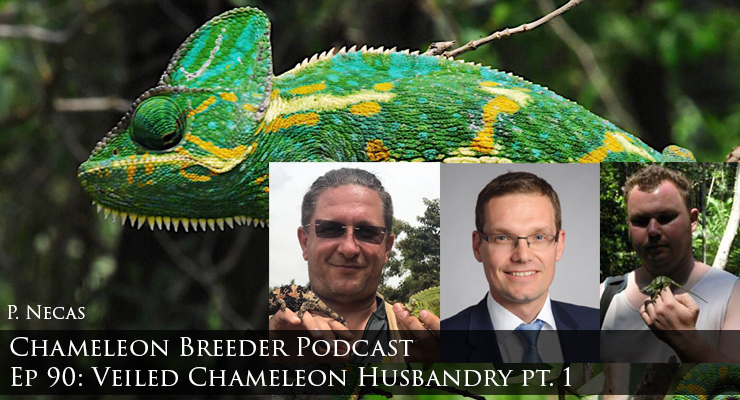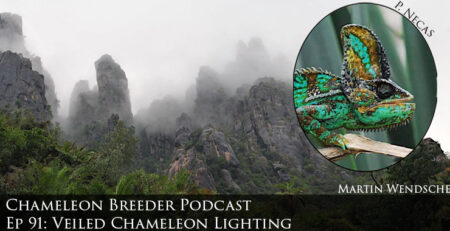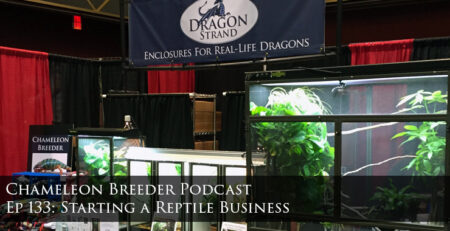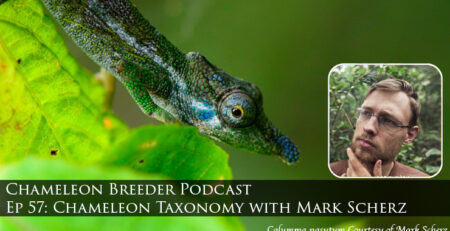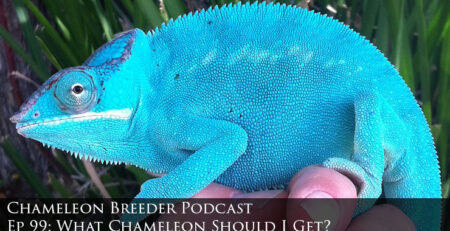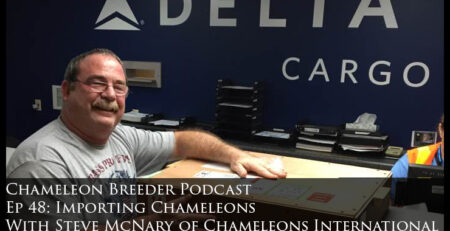Ep 90: Veiled Chameleon Husbandry – Natural Environment & Cage
Many thanks to Petr Necas, Martin Wendsche, and Petko Dvorak for sharing their experiences with both Chamaeleo calyptratus and Yemen. It has been a challenge to find travelers who have been to Yemen AND were Veiled Chameleon keepers/breeders. This was important because only keepers of Veiled Chameleons would understand the importance of questions we would ask. Thanks also to Alexandera Urbancova who was kind enough to offer audio translation of the Slovakian answers from Petko.
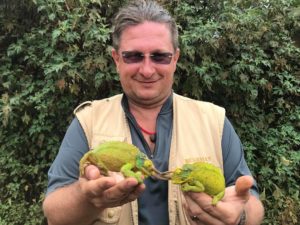

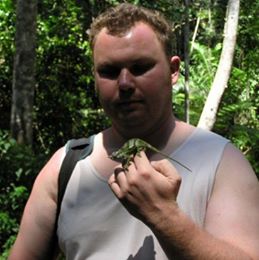
Martin shared the following images from Yemen:
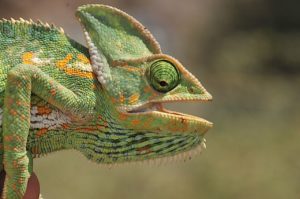
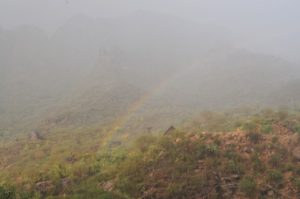
And a few images of Veiled Chameleons by Petr Necas
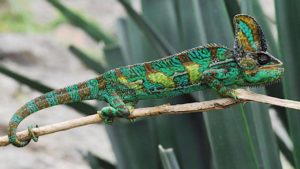
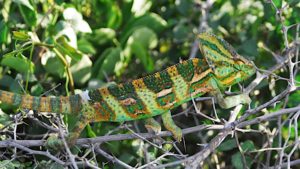
A view of an appropriate cage for a Veiled Chameleon. Notice the top basking zone, middle foliage zone, and the bottom cleaning zone. This provides a forest edge that allows the veiled chameleon to have both a basking area and a hiding area.
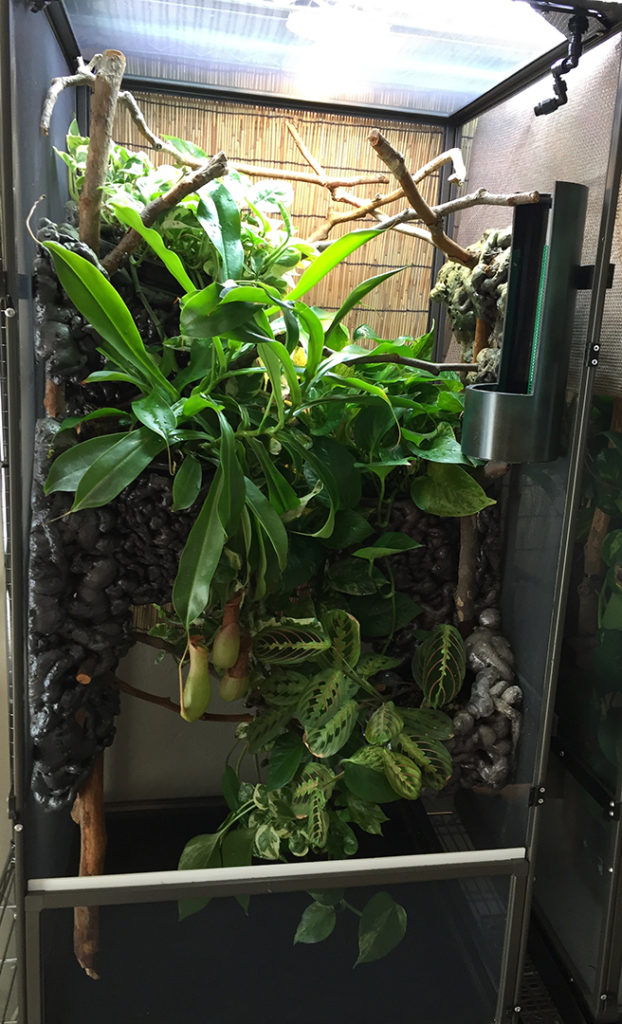
The following is a transcription of the podcast:
Introduction:
The Veiled Chameleon is one of the most popular chameleons to keep as a pet. Their hardiness makes them an ideal first chameleon. But they are still a chameleon – and that means some special attention needs to be put to their set-up.
Today I go over the basics of veiled chameleon husbandry to get you started in the right direction.
Introduction to Guests
This episode is about how to set up a cage and maintain husbandry for veiled chameleons. Veiled Chameleons are incredibly hardy. This tricks many people into thinking they have great husbandry when, in fact, the chameleon is just tolerating it. So how can you know what information to listen to? The answer to that is to research their natural conditions and mimic that as much as is possible. To do this we research the area on the internet and we talk to eye witnesses that have seen the chameleon in the wild and can share what they are doing during the day.
Veiled Chameleons, or, more accurately, Chamaeleo calyptratus, are a difficult species to do this for. They come from a country called Yemen which is in the Middle East at the Southern tip of the Arabian peninsula. Yemen is in a state of civil war and does not look like it is coming to a close anytime soon. But I was able to find three chameleon breeders that have extensive experience with Chamaeleo calyptratus and have travelled to Yemen to study their natural conditions. Together you and I will listen to what these travelers have to say and use each observation to construct a naturalistic approach to veiled chameleon captive husbandry.
I’d like to give a brief introduction to each of the men who were kind enough to answer my questions.
The first is Petr Necas. Petr is a world renowned herpetologist who has travelled the globe studying chameleons in their natural habitat. He has been featured in this podcast before as we have talked about the veiled chameleon and the region of Yemen. He is the author of the cornerstone book Chameleons: Nature’s Hidden Jewels, and visited Yemen many times during different seasons. Petr produced tens of thousands of veiled chameleons in captivity, made many of the initial studies of calyptratus husbandry, and was instrumental to introducing this species to captivity in both Europe and the US.
The second is Martin Wendsche from Germany. Martin is a long term, successful reptile breeder with interest in constrictors, crocodiles, chameleons and uroplatus. He too travelled in Yemen and observed calyptratus there. He also bred veiled chameleons in the 90s for 8 generations and produced many thousands of offspring.
The third is Petko Dvorak, A long term breeder from Slovakia. He was in Yemen several times to observe the behavior of Veileds. He also has bred them for many generations in captivity. And He has experience with more than 50 other chameleon species, Petko’s speaks only the smallest amount of English and preferred to send me responses through the voice of interpreter Alexandra Urbancova.
This will be an overview episode meant to highlight the important topics regarding keeping a veiled chameleon in a naturalistic manner. Each aspect of chameleon husbandry from hydration to UVB lighting to nutrition could have, and has had, books written about them… so if you are just starting out know that your journey only starts here! But the critical benefit here is that you know what to look for and research. The heartbreaking reality is that so many of the veiled chameleon issues we run into are from owners that truly wanted the best for their chameleon and were working off incomplete or just plain incorrect advice. There are well meaning individuals, even at pet stores, that give advice, but were not adequately prepared to give good advice. The saying is true – you do not know what you do not know. After listening to this episode – you will know.
Introduction to the Veiled Chameleon
Veiled Chameleons are also known as Yemen Chameleons and a variety of other common names. This is why anyone serious about chameleons calls them Chamaeleo calyptratusas that is the one name that is universal. To be absolutely exact, we would say Chamaeleo calyptratus calyptratusas there is actually another subspecies. But since Chamaeleo calyptratus calcariferis all but non-existent in the hobbyist market, saying Chamaeleo calyptratusis enough for now.
As a pet, calyptratus is full of personality. This personality is often grumpy, but it isn’t unheard of for a calyptratus to be mild mannered. Friendly calyptratus are rare, but do happen. The bottom line is that there is some taming that can be done, but if you get a veiled chameleon, you have to be prepared for the possibility that your chameleon will not like you. Please be careful here. Chameleon people love chameleons for what they are. We will take any personality chameleon and enjoy getting to know the quirks of our chosen tree dragon – whatever they may be. But if the type of personal interaction is important to you and your interest in your chameleon will lessen if he is not handle-able then it is time to reconsider your decision. If you want a pet that can be handled, chameleons are not the best choice. If physical interaction is important, please carefully consider if you should get a pet that is more in line with your desires. Keeping a chameleon is an incredible experience, but it will be a chameleon experience, not a dog/cat or human experience. Come into it with that mindset.
You will always get a choice between male and female because veiled chameleons are sexually dimorphic – this means males and females look different. You can tell the sex even from hatching by the male’s hind foot spurs –. If looks are important to you then make a choice by checking out images of adults. You can find some at the show notes for this episode if you like. If you are worried about the differences in care requirements then know that the personalities are the same, but with females they do have a tendency to lay eggs even if they aren’t fertile. This is not an issue if they are healthy. Proper husbandry without over feeding can give us this. They lay and it is over with. But it does mean that your husbandry has less margin for error with females because the egg laying process is quite stressful on the body. If this is your first chameleon and you are making a decision based on anything else besides seeing one and falling in love with that exact one, I suggest picking a male.
The basics of chameleon husbandry can be broken down into cage environment, lighting, feeding, and hydration. And we will touch on each one of these and apply our natural environmental insight.
Before we start talking about specific captive husbandry we need to have an understanding of where they come from so we’ll do a quick review. Veiled Chameleons come from Yemen on the Arabian peninsula. Although you may think that this is harsh environment there are veins of valleys in the mountainous regions that have a moist tropical vegetation zone. As this is so different from what we think of I’d like to play a description of the area from the view of Petr Necas who speaks from his travels there.
What is also interesting is that the geomorphology of Yemen is very specific. If you look at the southern part of Arabian Peninsula, you’ll find out that you have a coastal region, which is actually most a desert, lowland desert, dusty, full of sand, full of dust and very scarce revegetation. Then, it goes a little bit higher to food hills of the actually Hijaz Mountains that run along the Western shore of whole Arabian Peninsula, starting somewhere in Southern Jordan and crossing all the height of Saudi Arabia, reaching Yemen.
Between these high mountains and the coastal plains, there is an area which is called Tihama, which is not so high, but quite hot and tropical and there it starts to be interesting in our aspect because of chameleons because the tops of the hills are very dry, but in the deep valleys, which are called wadis in Arabia, there is always water. It is sometimes underneath the earth, hidden in the dry riverbeds that run through these wadis, but at least two to three months per year, they actually wear water, in a form of creeks or even quite big rivers.
This is what it makes special because in these small enclaves, which are very tiny network of these valleys, you find a climatic zone and a vegetation zone, which is equal to tropical, wet, moist climate of Africa. However, just two or three meters next to these areas, you have a completely dry desert environment that it cannot be inhabited by most of the animals that are actually confined to these zones
And this is why it is important to talk to people who have been there. The internet weather station will not reflect the microclimates within the wadis. We can get climate outside the Wadis, but that is incorrect data for chameleon husbandry purposes.
Now the important thing to realize is that we have this paradise only for the wet season from April through August. September brings some changes that are dramatic and also tragic for Chamaeleo calyptratus. We will get to that soon. For now, it is the wet season and the newly hatched babies are on a race to grow, mature, fight for territory, and mate. And this is where most of our focus in understanding veiled chameleon husbandry needs to be.
We know from temperature stations that the overall temperature in the general area during the summer will spike past 104F (40C) on the upper end and fall below the low 60s. The UV index often reads in the 11+ range which is brutal. But, let’s put this into perspective. These are around the same temperatures and UV Index levels we will experience in Miami, Southern California, or Hawaii. Is that really so bad? We keep hearing how Yemen is such a harsh place, but how bad can it be? Well, that all depends on if you can escape the elements or not. So are our veiled chameleons designed for triple digit temperatures and literally blistering UV? Or is this a case of the chameleon finding a way to escape the extremes? Does it bask at noon time, or hide during the afternoon like many other reptiles living in sun exposed environments? That is something only a person observing their behavior in the wild could tell us.
I’d like to bring Martin in. I asked him to share his observations as to what the chameleons were doing during the day – specifically their basking behavior.
The Yemen Chameleons show two peak activity patterns during day time. They bask and are active on the outer surface of the canopies of trees and bushes in the early morning hours and then shortly before sunset. They bask approximately two times, half hour to maximum one hour – not more. The rest of the day they spend, as a rule, deep in the bushes hiding from the sun and the heat. The only exceptions are the dominate males that might be found in the sun all day ‘round because they impose the other dominate males on the tops of the trees around showing their brightest colors. Their behavior however is solely motivated by showing off and imposing the other males – not by basking. They are simply resistant to it.
Petko, through Alexandera, responded as well.
It is rather hard to find them during the day time with the exception of the dominate males that are well visible on the tops of the tress. Others are rather shy and hide in the dense and thorny vegetation. They are quite easy to find at night with a torch. They form very dense populations with several animals per tree or bush.
So what we are hearing is that veiled chameleons are protecting themselves from these extremes in the shade. This is another example why you want to be very careful with gathering information from the internet. For example, shade can be 5 to 10 degrees lower than the outside temperature in the sun. UVB can levels can easily be cut in half. Context is critical.
These dense populations live, grow, mate and lay eggs. They are driven to do so in an anticipation deep within their genes of the coming dry season. When asked about the Wadis, Petko alluded to the coming hardship.
The climate in the Wadis is specific. Down in the Wadis lush tropical vegetation thrives in the rainy season while in the dry season they get completely dry so that even Acacias lose their leaves. The climate is typically hot during the daytime and very cold at night. The humidity at daytime is low. Even below 30%. At night it rises to 100% regardless of season. As temperatures reach the dew point so heavy fogs forms during the night and early morning hours all year ‘round.
For the dry season from September through March the trees lose their leaves. With the Acacia cover that protected them and their food gone, they are now exposed to the elements.
While both the temperatures and the UV Index are, thankfully, on the downswing, It cannot make up for the loss of shelter. With food, water, and cover gone, Martin brings us to a sobering conclusion.
The issue is that in the dry season you can hardly find any chameleons in the wild in Yemen. Where 100’s you could see before. It seems that they become nearly extinct in the dry season in the wild.
Those videos and pictures we see of veiled chameleons on a twig sticking up from the ground or in a leafless tree? These are snapshots of the end.
The calyptratus is a live fast species. They need to grow to sexual maturity, mate, and lay eggs before the dry season hits. Therefore, their job, when they hatch, is to gobble up as much of the insect life as they can as fast as they can to reach sexual maturity by four to five months old. In the wild they need to have laid their eggs by the end of the wet season.
This sounds like a bunch of trivial pursuit, but each one of these aspects has great meaning to us as keepers. The top things this means for us is:
- As a baby they will want more humid conditions than as an adult
- They will have voracious appetites as they attempt to grow at breakneck speed
- They will grow and mature quickly
- They can survive wide ranges of temperatures. Very hardy.
Veiled Chameleon Cage Size and Type
So let’s start laying out how we will get set-up for your veiled chameleon. The first thing to look at is your cage. There is a prevailing thought that baby chameleon need smaller cages than adults. Your new veiled chameleon can certainly be housed in smaller cages, but a two to three month old veiled chameleon will have no problem going straight into their adult size cage. They are hunters and there is nothing that will happen in a 48” tall cage that will escape their attention. Their eye sight is excellent and they will notice any movement in that cage. An adult size cage has the huge advantage that you are able to easily create gradients of heat, UVB, humidity, and exposure. If you choose to get a smaller grow out cage then you’ll have to do all the same measurements and observations anyways. It is just that the smaller the cage, the more difficult it is to give a gradient. I have an even harder time accepting using a grow out cage for veiled chameleons because they spend so little time small!
The reason people advise to get a grow out cage is so you can visually keep track of your chameleon and make sure it is eating and drinking. This has validity if you are just releasing food into the cage that wants to hide, but even with a smaller cage you would need to keep all the walls and floor clear for this not to be an issue and then you are risking the cage set-up to not be sufficient. A simple feeder cup takes care of this issue regardless of cage size. That said, if your veiled chameleon mentor insists that baby veilds need grow out cages then go for it. It won’t harm the baby at all. Just be ready to get the adult cage soon as they grow fast! But the one thing I will insist on is to not think that you can get a smaller cage for a female. Both male and female Veiled chameleons get sizeable. It isn’t like panther chameleons where the female is noticeably smaller than the male. Although, even then, I give my female panthers the same size as my males. I just do not like small cages for chameleons! If you are getting a veiled chameleon, male or female doesn’t matter, I advise getting, at least, the standard 2’ x 2’ x 4’ tall cage. Bigger is always better. . You can get shorter if the cage is wider
As far as cage type I would recommend a screen cage. To match natural rhythms we would want a higher humidity during their juvenile stage, but I’d rather create that with misters and foggers for the short months that they are young. As an adult we will want the drier conditions and a screen cage offers that ventilation as well as the sizes necessary to hold a chameleon that gets pretty big.
Internal Veiled Chameleon Cage Set-up
The inside of the cage has the requirements of the standard chameleon set-up. You’ll need two basic zones. The first is a clear area for basking. The second is a dense leafy area to hide and feel secure. I am going to use a standard 48” tall cage as an example, but these concepts are applied to any size or shape cage. This is just what chameleons need.
For a 48” tall cage I break it up into actually three zones stacked on top of each other. The top 12 inches of the cage is the basking zone. It is clear and consists of many perching branches. The middle two feet are the hiding zone. It is a dense collection of live plants that will obscure the chameleon from view. The lower 12 inches is for me. It is my cleaning zone. I keep this clear so I can easily monitor the poop. The frequency and size let me know how much is being eaten, the urates and appearance help me determine hydration. And it makes it really easy to clean!
The top foot is for heat and UVB. It is here that you want to create an area where both the heat lamp and the UVB bulb shine together. It is debatable whether chameleons will specifically seek out UVB or if they just warm themselves by the sun and UVB is part of the package. They really have had no time during their 100 million years of evolution to adjust to UVB and heat being from different sources so it is best if we make it so the chameleon gets its highest dose of UVB at the hottest point of the basking spot. This can be done by putting the UVB bulb in the last slot available on the fixture and placing that over the basking branch. The heat lamp is then angled to point at that basking spot. In this manner we have created a spot where the chameleon will naturally go to warm up and get its dose of UVB.
They need a dense leafy area where they can escape the heat, the UVB, and your sight. Yes, please take that seriously. You need to create areas that they can easily get to and perch in that you cannot see them in. They may not always use it. They may only use it to sleep in. Or, depending on your conditions, they may bask and then retreat to hide for that day only to come out in the late afternoon to hunt for dinner. Their behavior will depend on environmental conditions and individual personality. But it has to be there to give them a choice. To do this, make an area in the cage that is thick with plants. Ideally, live plants. In a 4 foot cage I make sure that the middle two feet are a dense thicket of leaves. I will say this again because it is the one thing that so many of the cages are obviously missing – A dense thicket of live plants that obscures your ability to see them. Your cage is inadequate without this. I know we all want to see them all the time, but this is not the chameleon way. Allow them to hide. And don’t worry, once they get comfortable with their cage and they learn that a closed cage door is protection they will spend most of their time out in the open. But don’t rush them. Let them get comfortable on their own schedule.
I want to add that live plants have many advantages including adding to the cage humidity and creating a living environment. But it is important to consider that veiled chameleons are special cases as they have a tendency to eat their foliage. So beware of plastic plants. Veiled chameleons have been known to take a bite of them too..
As far as plant types, the plant commonly called Pothos is a staple. Spider plants and Schefflera arbicola“umbrella plants” are very common at home improvement or even grocery stores. While some of these make it onto the toxic plants lists designed for cats, dogs, birds, and horses, veiled chameleons have been eating these for many years without issue so, by that evidence, we are comfortable putting them in a veiled chameleon cage and losing some leaves.
Now, the Cleaning Zone
The bottom of the cage I keep clear. This way I can monitor the poop. The frequency and consistency can tell me how much they are eating and how hydrated they are. The poop gives me an indication of their habits when I am not there to observe myself.
Some people will put a large plant in the floor in the middle. This is acceptable, but does complicate the bottom area as there is now a place for escaped feeders to hide. I feel so strongly about moving the plants up along the side of the cage that I invented the Dragon Ledge branch anchors through my Dragon Strand caging company to allow the mounting of horizontal branches and even potted plants. If you want to do it yourself there are other ways of accomplishing this. Just make sure you are using the frames to hold the weight and not the screen. You can check the show notes for a cage interior design that fulfills all the needs of a veiled chameleon.
Now, there are some horizontal cage formats available. Anything from 30” to 36” to 45”. I made the 45” wide Large Atriums through Dragon Strand to be the best commercially available veiled chameleon cages But other manufacturers make 36” wide cages as well. Wide format cages are great for veiled chameleons. If the cage is shorter in height then you just place the cage higher. The guideline I always give is that the main perching branch should be at your forehead level or above. This gives the chameleon a place where they can take security and feel they are above it all.
But with a horizontal format cage you no longer are no longer limited to creating vertical levels. You can now create zones going left to right. Some of my greatest cage designs were with these horizontal format cages because you can now designate, say, the right side of the cage to be the clear area, the middle of the cage is the start of the forest edge and the left side of the cage can be dense leaves from top to bottom. With this format, you can use the right open side as a place to hang your feeder cups or release feeders to run up the wall. This fits in perfectly with their natural habit of coming to the forest edge in the mornings and evenings to hunt for food.
I love these larger cages because you have so much more space to work with to create a living environment with a variety of gradients.
I know we usually think of people making their own cages for Parson’s Chameleons or Meller’s Chameleons. If you are a veiled chameleon keeper, I encourage you to think about making a huge cage for your chameleon. Think wider, as well as taller, but remember that chameleons are horizontal animals. They will love wider.
I would like to touch on outdoor keeping for veiled chameleons. Their wide temperature range means that there are a number of months out of the year that you can probably keep them outdoors – depending on your geographical location. Some of us are lucky that we can keep veiled chameleons outdoors year round. California and Florida are great candidates for this! I have had mine outdoors in temperatures that ranged from the low 40sF during the winter to 105F during the summer. This is possible with animals that are 1) acclimated to the slow progression of temperatures over the seasons. Do NOT just put your indoor chameleon outdoors in temperature extremes. 2) This was in large, heavily planted cages. I ensured that there was a defined basking zone, but the critical area was a dense plant cover area so they could retreat 100% into the bushes to escape both the heat and the cold. 3) I had a natural soil bottom. This is where the plants were planted and the exposed soil gave off humidity. A totally blocked or shaded, moist area of soil provides a surprisingly cool retreat. Your chameleon naturally goes down to escape heat. With this set-up he finds what he is looking for. Plant your outdoors cage with vining and flowering plants. Not only will this be a joy to build and watch, but the natural plant life will attract natural bugs to supplement your chameleon’s diet. This is so important to me that each one of my chameleons has an indoor cage and an outdoor cage. And they stay in the outdoor cage as long as possible. I highly recommend this experience. There is something about being outside in this manner that makes chameleon keeping enormously simple. Insert food and water and they pretty much take care of themselves
We will break here. In the next episode we will go over lighting. From artificial day light to UVB to heat. These are critical to a chameleons mental and physical health. With each aspect of captive husbandry, observing the veiled chameleon in the wild is key to understanding how to do it best. Thank you to Petr, Martin, and Petko for sharing their eye witness accounts of the veiled chameleon in Yemen. Their observations give us the context we need to interpret the information we gather. And I thank you, listeners, for joining us here. You are the reason we do this.

